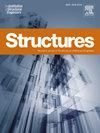Engineering evaluation of deterministic ground-motion simulation based on the dynamic response of Pine Flat dam
IF 4.3
2区 工程技术
Q1 ENGINEERING, CIVIL
引用次数: 0
Abstract
Despite significant advances in deterministic ground-motion simulations, their application in engineering practice is still constrained due to reliability concerns. Current studies on deterministic ground-motion simulations typically evaluate simulated ground motions by comparing single parameters like peak ground acceleration (PGA), peak ground velocity (PGV), and spectral acceleration. However, limited research has explored whether these simulations can accurately replicate the dynamic responses of complex structures—a critical requirement for practical engineering applications. This study evaluates the feasibility of using fully deterministic numerically simulated ground motions for dam dynamic analysis. Taking the dynamic response of a gravity dam as a benchmark, we propose several structural response parameters to quantitatively assess the reliability of simulated ground motions. The 1994 Northridge earthquake is simulated with a newly proposed multidimension source model and the refined velocity structures. The simulated ground motions, along with recorded data at 32 stations, are used as input ground motions for the seismic response analysis of the Pine Flat gravity dam. Results from the linear-elastic seismic analysis show that the principal stress distribution in the dam due to simulated ground motions is generally comparable to that observed with recorded ground motions. Furthermore, the nonlinear seismic analysis shows that the maximum relative displacements and damage of the dam subjected to both the recorded and simulated ground motions are in good agreement at most stations. The comprehensive validation results demonstrate that deterministic broadband ground-motion simulations offer a promising and reliable approach for performance-based seismic analysis of engineering structures.
基于松坪坝动力响应的确定性地震动模拟工程评价
尽管确定性地面运动模拟技术取得了重大进展,但由于可靠性问题,它们在工程实践中的应用仍然受到限制。目前的确定性地面运动模拟研究通常通过比较峰值地面加速度(PGA)、峰值地面速度(PGV)和谱加速度等单一参数来评估模拟的地面运动。然而,有限的研究已经探讨了这些模拟是否能够准确地复制复杂结构的动态响应-这是实际工程应用的关键要求。本研究评估了利用完全确定性数值模拟地震动进行大坝动力分析的可行性。以重力坝的动力响应为基准,提出了几个结构响应参数,定量评价了模拟地震动的可靠性。用新提出的多维震源模型和改进的速度结构对1994年北岭地震进行了模拟。模拟的地震动与32个台站的记录数据一起,作为松坪重力坝地震响应分析的输入地震动。线弹性地震分析结果表明,模拟地震动引起的坝体主应力分布与实测地震动的主应力分布基本相当。此外,非线性地震分析表明,在大多数台站,记录的和模拟的地面运动对大坝的最大相对位移和损伤的影响是一致的。综合验证结果表明,确定性宽带地震动模拟为基于性能的工程结构地震分析提供了一种有前途和可靠的方法。
本文章由计算机程序翻译,如有差异,请以英文原文为准。
求助全文
约1分钟内获得全文
求助全文
来源期刊

Structures
Engineering-Architecture
CiteScore
5.70
自引率
17.10%
发文量
1187
期刊介绍:
Structures aims to publish internationally-leading research across the full breadth of structural engineering. Papers for Structures are particularly welcome in which high-quality research will benefit from wide readership of academics and practitioners such that not only high citation rates but also tangible industrial-related pathways to impact are achieved.
 求助内容:
求助内容: 应助结果提醒方式:
应助结果提醒方式:


